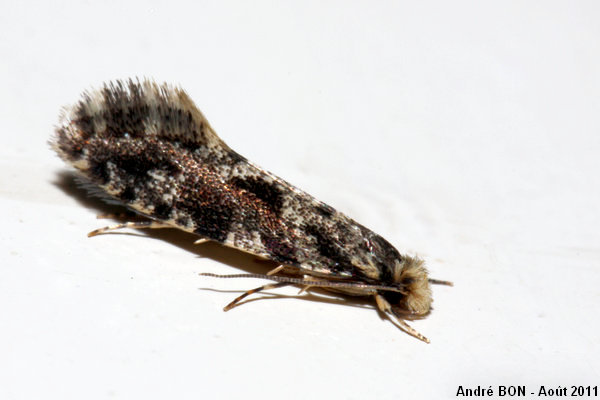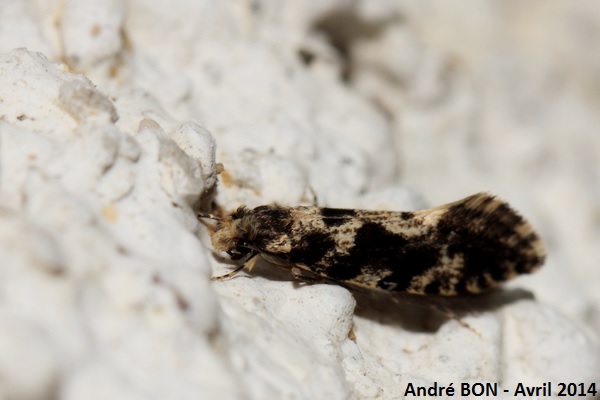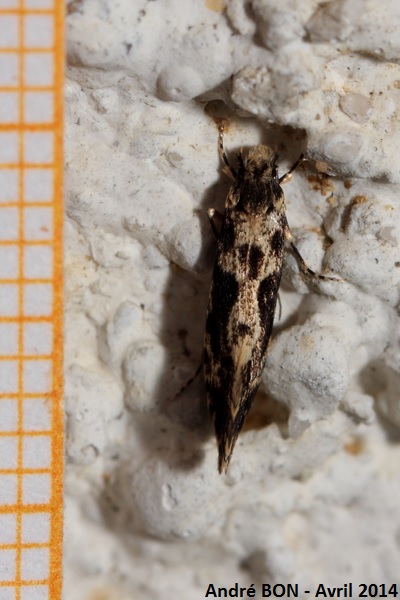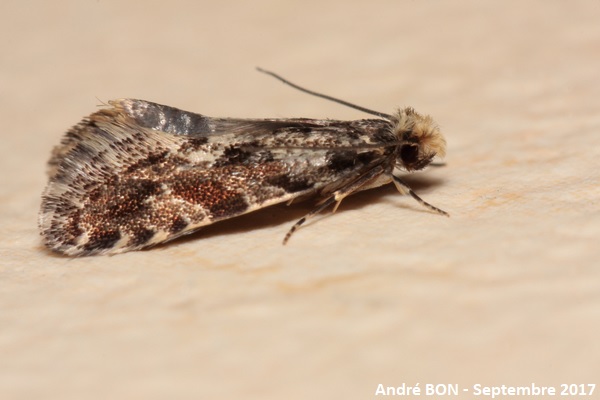



| European Grain Moth (Nemapogon granella (Linnaeus, 1758)) |




|
|
Scientific name: Nemapogon granella (Linnaeus, 1758) Common name: European Grain Moth French name: Teigne des grains, Teigne européenne des grains, Teigne des blés. Order: Lepidoptera Suborder: Microlepidoptera Family: Tineidae Subfamily: Nemapogoninae Wingspan: 10-15 mm. Biotope: Woodland areas with many dead trees but also in the vicinity of human activities with storage of foods. Geographic area: Originated from western Eurasia, the European Grain Moth may be found worldwide because of transportation of food. Introduced populations are very often only temporary and do not establish for a long time. Flight time: Mainly from March to September but also all year round in relationship with human activities linked to storage and transportation of food. Number of generations : 1 Caterpillar: White with a brown head. Host plant: Fungi growing on dead wood like the Birch Polypore (Piptoporus betulinus) for example. Populations growing in the vicinity of human activities feed on dry fruits and cereals among others. |
Moths of the Nemapogon genus show the typical shape of the Tineidae family with their wings positioned as a roof shape, the fringe up. The head is covered with a tuft of hairs. The wings are marbled with white and brown. The species are very similar and difficult to tell apart on pictures. The European Grain Moth bears a yellowish white tuft of hairs on the head. The antennae are longer than one half of the wings. There is a row of large black spots on the costal edge which merge with inner spots to form some kind of a zigzag marking. There is no well marked white discal spot in the postmedian area. Several species in this genus show a tuft of white hairs on the head. The two other species showing yellowish white hairs are Nemapogon wolffiella and Nemapogon cloacella. Nemapogon cloacella is a slightly paler overall colour. The wings are marbled with dark brown, with white and with paler yellowish brown. The white spots on the costal edge are not so well delimited. There is a well marked white discal spot in the postmedian area. Nemapogon wolffiella has its fore wings marbled with white and dark shiny brown with large patches giving an overall rather dark colour. The costal edge of the fore wings show six rather well delimited white marks. The three ones close to the apex are curved and hook-shaped. Among species with white hairs on the head, Nemapogon ruricolella shows pale brown marks, especially near the tip of the wings. Nemapogon variatella has narrower wings. |
| [To know more about the European Grain Moth] [Next picture] [Top] |

|
I had initially listed this small moth as Nemapogon wolffiella but I have changed my mind because of the observation of other specimens and because the white spots on the costal edge do not appear so well marked for me. The lack of a well marked white discal spot and the dark colour are the criteria that permit to discard the Nemapogon cloacella species. |
| [To know more about the European Grain Moth] [Next picture] [Previous picture] [Top] |

|
I have listed this specimen as Nemapogon granella, as before, because of the global aspect of the white spots on the costal edge. I am interested in any information that could confirm or infirm this choice. |
| [To know more about the European Grain Moth] [Next picture] [Previous picture] [Top] |

|
Upper side view. The wingspan is about 15 mm. |
| [To know more about the European Grain Moth] [Previous picture] [Top] |

|
Here is a close-up view. I am used to observing a few specimens of this Grain Moth in my workshop where I do not store any food except my hazelnuts. Is there a link? It is also possible that the caterpillars grow on the Birch tree that is close to the door. |